Aleister Crowley, Loki’s Brood & the Fury of Hell...
Part 2
By Jack Heart & Orage
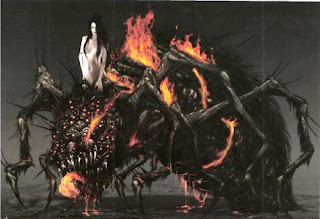
By the end of WWI, William Butler Yeats knew exactly what was coming. The most famous poem in the Michael Robartes and the Dancer collection is “The Second Coming.” Yeats begins it:
“TURNING and turning in the widening gyre
The falcon cannot hear the falconer;
Things fall apart; the centre cannot hold;
Mere anarchy is loosed upon the world.”(13)
The Egyptian hieroglyph for Horus is the falcon. In the aftermath of WWI’s carnage, Yeats sees clearly that nothing can control the God of War and Vengeance: “The blood-dimmed tide is loosed, and everywhere / The ceremony of innocence is drowned.” In the poem’s last line, Yeats asks “And what rough beast, its hour come round at last, slouches toward Bethlehem to be born?”(14) Yet he has already described the Beast with all the skill that his prodigious talent as a poet would allow:
“A shape with lion body and the head of a man,
A gaze blank and pitiless as the sun.
Is moving its slow thighs, while all about it
Wind shadows of the indignant desert birds.
The darkness drops again but now I know
That twenty centuries of stony sleep
Yeats had been vacillating ever since 1913, when he had slain Michael Robartes in a short story titled “Rosa Alchemica.” Right before the turn of the century in The Wind Among the Reeds, Yeats had said of his muse: “Michael Robartes is the pride of the imagination brooding upon the greatness of its possessions, or the adoration of the Magi.” (16)Were vexed to nightmare by a rocking cradle.” (15)
But by 1913, it was entirely different. Michael Robartes had now metastasized into one of the Golden Dawn’s infamous “hidden masters,” the supernatural beings whose disputed existence and direction caused a schism within the group that was settled by Aleister Crowley's pistol.
In the story, Robartes appears at his door after a fifteen-year hiatus and forces Yeats with mind-bending incenses to accompany him to a temple by the seaside, where they are besieged by an irate Christian mob. During the night, Yeats participates in a ceremony with a cult similar to the Golden Dawn. When he awakens in the morning, he finds that the ornate temple has now become an old barn, and he is unable to rouse Robartes and the rest of the cult who are in a trance-like sleep. As Yeats flees, Robartes and the cult are stoned to death by an enraged Christian mob.
Yeats then waxes poetic as he delivers Robartes’ eulogy, which is a reflection of his own faltering courage. Yeats renounces the deception of “Legion,” like a little Catholic boy renouncing the Devil, wrapped in the imaginary protection of his rosary beads. Yeats’ insecurities didn’t last long, though. By 1916, his guilt for what they had done combined with his grandiose opinion of himself had convinced him that he was the incarnated Sun God and could pull off the Great Work by himself.
The first two poems in Michael Robartes and the Dancer are about Yeats’ own love life. In the first poem, the title poem, Yeats refers to himself as a “half-dead dragon” in the eyes of the much younger Iseult Gonne, whom it seems Yeats believed to be the incarnated soul of the moon. Iseult was herself of magical birth, being conceived in an act of sexual Magick, as the aristocracy has been practicing for thousands and thousands of years. She was among the kings and queens of Europe a legendary beauty and the daughter of their own residing wild woman Maud Gonne.
Iseult Gonne
Please support us through Patreon.com/jackheartwriter
Undaunted, our rejected self-appointed Sun God next proposed to Maud Gonne whom he believed to be the rest of the Pagan female pantheon. Rejected again, our intrepid Sun God married his fellow Golden Dawn initiate, twenty-four-year-old Georgie Hyde-Lees, the witch of “Solomon and the Witch,” the second poem of the Robartes collection.
The proposals all took place in 1916, a year in which Yeats was obviously desperate to marry. The year 1916 appears in another verse of the collected works. “Easter, 1916” is a poem first published back in 1916. On the surface, it appears to be about Irish nationalism, but contains the line “When sleep at last has come on limbs that had run wild,” a sentence that could be interpreted pornographically. Easter is also the day of resurrection in Yeats’ Christian security blanket. Regardless of the ambiguity of “Easter, 1916,” Yeats’ meaning in “Solomon and the Witch” –the second poem of Michael Robartes and the Dancer– is perfectly clear.
“AND thus declared that Arab lady:
'Last night, where under the wild moon
On grassy mattress I had laid me,
Within my arms great Solomon,” (17)
Most of the works translated from Latin by Jung were originally written in Aramaic; in Aramaic works such as Turba Philosophorum, Solomon is the Sun God.
“I suddenly cried out in a strange tongue
Not his, not mine.'
And he that knew
They were speaking gibberish to each other in the heat of passion. Yet Yeats no doubt convinced himself and her that they were speaking Enochian, a language either discovered or invented by John Dee, which according to occult traditions like those of the Golden Dawn was the authentic angelic language.All sounds by bird or angel sung” (18)
“Answered: 'A crested cockerel crew
Upon a blossoming apple bough
Three hundred years before the Fall,
And never crew again till now,
And would not now but that he thought,
Chance being at one with Choice at last,”
“All that the brigand apple brought
And this foul world were dead at last.
He that crowed out eternity
Thought to have crowed it in again.
A lover with a spider's eye
Yeats is expressing his longing for vindication of man’s expulsion from paradise and a desire for vengeance. During a vision of Walpurgis Night in Moonchild, Crowley depicts God as an “enormous spider” who sits at the center of a web whose strands are made of all the other gods man has ever worshiped. So when Yeats says, “A lover with a spider's eye will find out some appropriate pain,” he is again expressing his and his Luciferian brethren’s thirst for vengeance.Will find out some appropriate pain,” (19)
“Aye, though all passion's in the glance,
For every nerve: lover tests lover
With cruelties of Choice and Chance;
And when at last that murder's over
Maybe the bride-bed brings despair
For each an imagined image brings
And finds a real image there;
Yet the world ends when these two things,
Though several, are a single light,
When oil and wick are burned in one;
Therefore a blessed moon last night
Gave Sheba to her Solomon.' '
Yet the world stays':
'If that be so, Your cockerel found us in the wrong
Although he thought it worth a crow.
Maybe an image is too strong
Or maybe is not strong enough.'
The night has fallen;
not a sound In the forbidden sacred grove
Unless a petal hit the ground,
Nor any human sight within it
But the crushed grass where we have lain;
And the moon is wilder every minute.
Yet the world ends when oil and wick are burned in one – this is the part that always scared schoolchildren like Yeats playing at being Magi. They use images conjured, while they are in the throes of sexual ecstasy or murdering little children. It’s always that murder, that is over and never this one, their own. That’s why the bride-bed always brings despair and the world stays. Cowardice dictates that their cockerel always will find them in the wrong and that they will never be worth even a single crow.Oh, Solomon! let us try again.” (20)
But always they will try again, because to them it’s nothing but fine entertainment. In one of the woodcuttings in Le Songe de Poliphile, the lovers are hacked to pieces and their severed limbs fed to the beasts of the forest; in others, the severed limbs are steeped in a vat filled with the amniotic fluid of the wind. The Royal Art is not for squeamish peasants and must be carried out with the conviction of a king and a queen. Figure 6 must take place in this world, not in some forbidden sacred grove in a phantasmagorical parallel world.
Crowley had been performing terminal sexual Magick at least since the Amalantrah Working. In 1924, Mussolini would expel him from Italy when a young nobleman died at his abbey from the practice. He was advising candidates in what he called the rite of “Eroto-Comatose Lucidity.” The object was to prolong intercourse through “every known means. Every device and artifice of the courtesan is to be employed, and every stimulant known to the physician.” When delirium is achieved, so is commune with the sublime, and when finally the orgiastic carnality can no longer be continued, Crowley advised his supplicants “the Initiate may then be allowed to sleep, or the practice may be renewed and persisted in until death ends all. The most favourable death is that occurring during the orgasm, and is called Mors Justi…” (21)
Throughout the second half of the twenties, Crowley would continue his quest to “die the death of the Righteous”(22) in France with any of the West’s more adventuresome elitists who were willing to participate. In 1928, France would finally ask Crowley to leave, because by then they knew his sympathies lay with Germany in a war over a decade away but already as inevitable as the next sunrise. Crowley would go to his beloved Germany for a while, but 1933 would find him back in England where he had come to get some satisfaction in her courts about the slander the British intelligence services were busy spreading about him all over Europe and America.
Perhaps for reasons known only to himself (because he was much smarter than that) after taking Figure 11 and calling it 5a, Jung chose to dismiss the entire second half of Rosarium philosophorum as a “concession to feminine psychology.” He said, “The first series of pictures is followed by a second – less complete, but otherwise analogous – series, at the end of which there appears a masculine figure, the ‘emperor,’ and not, as in the first, an ‘empress,’ the ‘daughter of the philosophers.’ The accentuation of the feminine element in the Rebis (Fig. 10) is consistent with the predominantly male psychology, whereas the addition of an ‘emperor’ in the second version is a concession to a woman (or possibly male consciousness).” (23)
Miguel Serrano was one of the very few writing about the occult in the twentieth century who grasped the significance of what he called the union between the He and the She. Serrano, one of Jung’s closest personal friends, accused the great psychologist of attempting to “psychologize” the raison d'être of human existence with his clinical analysis of Rosarium philosophorum. It is Serrano’s contention, and that of the SS for whom Serrano is speaking, that this timeline where everything that’s bad is good and everything that’s good is bad only still exists as a prison for the human soul because Rosarium philosophorum has never been properly performed.
The king and the queen of souls, even if incarnated into the flesh, are not a natural man and a natural woman; they are the templates by which man and woman are made. There are many worlds, and the king and the queen of souls exist in each and every one of them simultaneously. In the second set of figures illustrating Rosarium philosophorum, the operation has been diverted to just such a world, one that Yeats called the “forbidden sacred grove.” In the sacred grove, the king and the queen are what Jung called vapores, or fumi, spirits with wings; that is how they copulate. This is a completely Black operation and is sanctioned by neither the Holy Spirit nor Hell itself. There are no crows in this operation, and it leaves the Sun – the true soul of the king – trapped alone in his sarcophagus.

Figure 12
It is a soulless king who dies with the queen in this phantasmagorical dreamworld where nothing ever really dies, and therefore nothing new can ever really be created.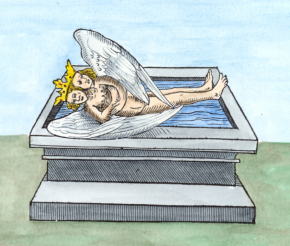
Figure 13
Consequently, since there is no male soul, it must be the woman’s soul that leaves the nuptial sarcophagus and ascends into the clouds above.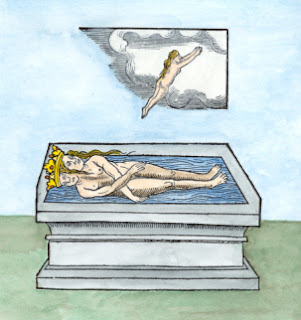
Figure 14
And it is a woman’s soul that descends from the clouds to reanimate the corpse in Figure 16. There are no crows present, because nothing has really died. There can be no resurrection. Hell, which is simply a name for the many worlds of the dead along with the great Goddess Hell, whose name is eponymous to those worlds which she rules, has been bypassed.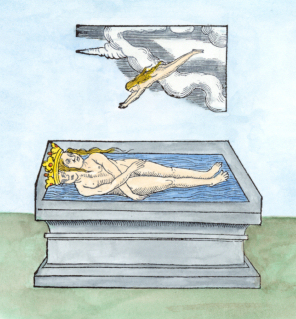
Figure 16
In Figure 17, instead of a super being motivated by female empathy and fortified by the convictions and courage of a man, a monster is born into the world. It is not an empress at all, but rather an emperor motivated only by male cruelty fueled by an insatiable appetite for judgments. However, it is a cruelty carried out through female deception. His wings of a dove have been replaced with the wings of a bat, a creature of the darkness; he stands upon his own judgments, which devour themselves. Behind him crouches a ravenous lion, and he holds aloft the crested serpent over the pillar of mercy, where now the young must be fed with the flesh of their mother. In the pillar of severity, the judgments of the Magi are upon the Sun God. It is his severed heads that now hang from the tree.
Figure 17
This is the current world, the world man “lives” in, a Christian world. In Figure 18, the lion ultimately devours the Sun, forever cursing a world gone bad to exist in eternal darkness and live a relentless lie.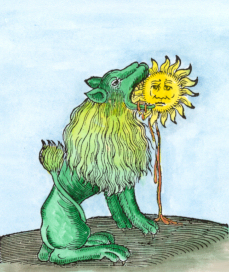
Figure 18
There is a rumor from beyond the veil of a thousand years that it was Mary Magdalene who brought Christianity to the South of France, references in Sagas from time out of mind to women on a mighty mountain, wave maidens, and supernatural women. They are led by a goddess named Freyja, who has her own heaven called Folkvang, coterminous with Valhalla. According to the Prose Edda, of those brave men killed in battle “one half of the slain belong to her, and the other half to Odin.”Freyja has had many names; she has been all over the world searching for her lost mate, crying golden tears. Tacitus, the Roman historian, makes mention of the inexplicable worship of Isis among the ancient Teutonic tribes. There is Venusberg in German and Mont de Venus (Mountain of Venus) in French. It’s an old Germanic story of a knight who after slaking his carnal desires with the women of the forbidden mountain seeks forgiveness from the pope, who gives him only dead roses. When the Goddess finds out, she makes the roses bloom. Wagner’s famous opera Tannhäuser is based on the story.

Tannhäuser in the Venusberg by John Collier, 1901
It is the pope’s deepest, darkest secret that there never was a man named Jesus, but there was a woman with many names because she has been all over the world crying golden tears searching for her lost lover. Jesus is really a woman – or more correctly a goddess. That is the real reason a war of extermination was waged upon the Cathars, for they knew this. In Figure 19 she is crowned Queen of Heaven by the Father and the Son and a crested bird, certainly not the dove sanctions her coronation.
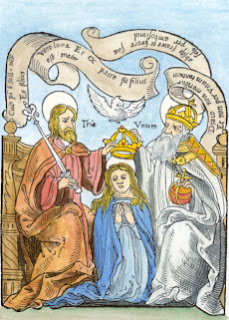
Figure 19
In Figure 20, she steps furtively from her sarcophagus. She is still wearing her hair in the same manner she has worn it in the other sixteen woodcuttings that depicted her, but now she has a beard. She has become Jesus, the Alpha and the Omega, charged with saving herself as the exiled soul of the human race. Alone, she is not up to it. Behind her head is ostensibly an oversized halo that is in reality the Moon. In her left hand, to quote Guns n’ Roses, she carries “the cross of homicide” that will bring a thousand years of pain and suffering to the world. No good has ever come of a lie.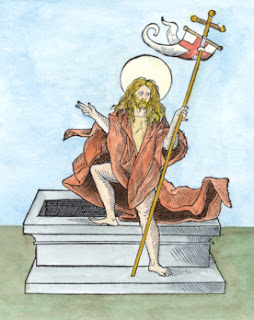
Figure 20
I may have been dreaming about Aleister Crowley, but when I had that dream I knew very little about the Boleskine House and even less about the Norse. Besides the two sons murdered by the gods, one whose intestines they used to bind Loki until the end of time, Loki had three other children with a giantess named Angerboda which means bringer of distress. Angerboda is no doubt the witch of Baldrs Draumar, whom Odin recognizes at the end, dismissing her story of Baldr’s impending doom.
"No wise-woman art thou, | nor wisdom hast;
Of giants three | the mother art thou." 24
She then tells him to go home and be proud, because he will be the last one who ever sees her until Loki slips his bonds and sets loose the destroyers of all. Loki has already been restrained for telling the gods the truth about themselves; he only threatened to kill Baldr when Baldr’s mother Frey, Odin’s wife, told him Baldr would kill him for insulting her.
In his sixteen-volume Gesta Danorum (Deeds of the Danes) Saxo Grammaticus, a Danish historian noted for his brilliance with the Latin language ... who was writing over fifty years before the Prose Edda was composed, tells an entirely different tale of Baldr’s death. Baldr was killed in a sword fight with his brother, the blind god Hoder, over Baldr’s wife Nanna. Saxo calls Baldr “a vicious and lustful demigod.”25
Angerboda’s apparition to Odin and Baldr’s troubled dreams are the beginning of Ragnarök in time out of mind long before the Prose Edda, a product of the Christian infection which had to have a dying god to represent Jesus. Baldr was a minor god. Outside Baldrs Draumar, he is hardly even mentioned in the Poetic Edda. Just like the lie of a god Jesus he was later remodeled after, he has nothing to do with what causes Ragnarök.
As Tacitus has already said when he called him Mercury, Loki was a god much worshiped by the Germanic people. The other gods made a fatal mistake when they tested him.
The three offspring of Loki and Angerboda are just as feared by the gods as is Loki himself – and rightfully so, particularly since the gods have taken the liberty of submitting their father to eternal torture and unjust incarceration. After what was done to Loki, war with the three great dark gods would be as inevitable as Loki’s vengeance.
Loki’s daughter will not be attending any debutante balls in the foreseeable future. The Norse called her Hel. Her name is eponymous with the place called Hell in Old English, Helle in Old Frisian, and Hellia in Old Saxon. Long ago, the Germans called her Hella and the Goths Halija. All the names are derived from the reconstructed Proto-Germanic feminine noun xaljō, meaning concealed place or the underworld.
According to the Prose Edda, “The plate of the goddess Hel is called Hunger (Hungr), her servants Slow (Ganglati) and Lazy (Ganglöt), the threshold of her door Stumbling Block (Fallandaforað), her bed Illness (Kör), and her curtains Bleak Misfortune (Blíkjandabölr). Few scholars accept such descriptions as being authentic products of the Viking Age.” 26 Like much of the Prose Edda, the description of Hell is blatant Christian propaganda. The sources say no such thing; in fact, they indicate there are many worlds in Hell.
Saxo Grammaticus, who doesn’t use the word Hell because undoubtedly he knew it would be appropriated by Christianity in the near future, writes of a man named Hadingus, who visits the underworld guided by a witch: “There he sees the ever-lasting battle taking place, a fair land where green herbs grow when it is winter on earth, and finally a wall which shuts in a strange land, about which no more is told us than that the woman herself could not pass the barrier into it, and that when she cut off the head of a cock she had with her and flung it over the wall it came to life again immediately, and could be heard to crow.”27
The Christian proselytizing of the Prose Edda includes a brief description of Hell herself: “One-half of her is blue, and the other half is of the hue of flesh; hence she is easily known. Her looks are very stern and grim.” 28 Hell’s half-blue coloration invites comparisons to the Vedic goddess of death Kali, who is usually depicted as blue, but what the Prose Edda is really alluding to is Persephone and the Eleusinian Mysteries. In fact, in Saxo’s very different account of Baldr’s death in the Gesta Danorum, he refers to the goddess of death as Proserpina, the Latin equivalent of the Hellenic Persephone.
Homer called her “dread Persephone” and described her as the formidable yet venerable and majestic princess of the underworld, who carries into effect the curses of men upon the souls of the dead. In Crete, she was called Eileithyia and was intimately entwined with the nameless goddess of the labyrinth, the birth of the divine Child, and Enesidaon the earth shaker. In Çatalhöyük, she was again the nameless great goddess, this time accompanied by a boyish youth whom she corrupted.
Empedocles, the ancient Pythagorean poet who invented the cosmological theory of the four elements, said, “Now hear the fourfold roots of everything: enlivening Hera, Hades, shining Zeus. And Nestis, moistening mortal springs with tears.” In Empedocles’ system, each of the gods represents an element; Nestis, who is water, is a pseudonym for Persephone the terrible Queen of the Dead. In Empedocles’ time, her name was forbidden to be spoken out of fear of her and was usually substituted for with Kore, meaning the Maiden.
Later in the Eleusinian Mysteries of Greece, Persephone is the daughter of the great goddess Demeter, who controls the fertility of the land. Persephone is kidnapped by Hades and whisked off to the underworld to be his concubine. This abduction enrages Demeter, who brings famine to all the land, causing the other gods to force Hades to return Persephone to her. She then restores the land. But Hades has tricked Persephone into partaking of food in the underworld which by decree of the Fates themselves condemns all who consume it to eternity there. An accord is reached whereby Persephone spends half her time in the underworld and half her time in the land of the living, metaphorical of the death and rebirth in agricultural seasons and synonymous with the blue and white color of Hell.
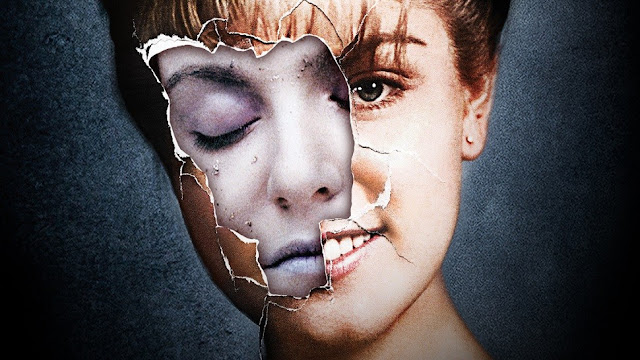 |
| Laura Palmer in Twin Peaks |
In Arcadian myth, isolated from outside influence for millennia, the river spirit of the underworld appears as a horse and mates with Demeter, also in the form of a horse, who then gives birth to a horse. In northern European folklore, deities regularly take the form of horses. To the Minoans who wrote in Linear A, an ancient Greek language that will never be deciphered because it was not invented in a monastery, Enesidaon, the earth shaker is synonymous with Loki, who writhes in agony as venom drips on his face. In the Lokasenna, Loki mocks the goddess of agriculture Gefjun for having corrupted a youth, tying some of the stories in the Poetic Edda to Çatalhöyük… until the discovery of Göbekli Tepe, the oldest known civilization.
The Goddess of Death is as old as the Ancient of Days. Xaljō, the root word of Hell, is a feminine noun. But the days of this timeline may be naught but the product of an Aleister Crowley spell. It was a spell that was cast on the Sleeping Beauty of Germanic folklore. In sleep, a sharp external noise can bring on the most elaborate of dreams, each phantasmagorical scenario built on the last phantasmagorical scenario, all in the seconds before the dreamer awakes. Time means nothing in a dream. There is only here and now, and it’s all retroactive. What’s done today and tomorrow becomes yesterday. It’s been said before: this is the Morning of the Magicians. If that is so, then it is Otto Rahn who is its architect.
He writes in Lucifer’s Court: “There is an Indian word, Titthakara, which, originally, meant ‘discoverer of a ford’; it stood for a person who had found a passage there where others had searched in vain for a way to cross to the other side. In one way, such a Titthakara showed us the ford to pass from one side of the river to the other. Here is what this means: he knew how to guide across the thick obscurity which stretches before men and separates them from what they can only know after their death...” 29
Rahn is telling those who have ears to hear that he is the Titthakara. Somewhere in the grottoes of the Sabarthes, he found the Grail and split the timeline, perhaps in the grotto of Lombrives by the tomb of Heracles, who mourned his lover Pyrene for whom the Pyrenees Mountains are named. She was torn apart by wild beasts before Heracles could answer her cries for help. Again the Goddess dies.
“You dig in places till your fingers bleed
Spread the infection, where you spill your seed
I can't remember what she came here for
I can't remember much of anything anymore
She's gone, she's gone, she's gone away
She's gone, she's gone, she's gone away
Away...
A little mouth opened up inside
Yeah, I was watching on the day she died
We keep licking while the skin turns black
Cut along the length, but you can't get the feeling back
She's gone, she's gone, she's gone away...”
– “She's Gone Away” by Nine Inch Nails in Twin Peaks, Season 3, Episode 8
https://youtu.be/QczxCxFRUf0
Leading up to Ragnarök in Lucifer’s Court, Rahn writes: “Lady Hel is Death not Life, even though she deals with all that lives. Just as a woman may not give birth without first having been fertilised by a man, Lady Hel also needs a husband. And the woman-earth and man-sun celebrate their union so that a child might be born: Life. To embrace the goddess of Death, the sun lowers himself onto her, that is to say towards the earth. During the night of the winter solstice, they celebrate their ‘hierogamy’, their sacred union. Conquered by the power of the male god. Lady Hel gives herself to him and becomes a mother. ‘Glory to you, Earth, mother of men! Believe in the embrace of God, fill yourself with fruit for the good of men!’ Once, the Anglo-Saxon peasants would address this prayer to their fields, as they worked and seeded them.
Lady Hel is also Love, bearer of new life; and it is because all life must one day perish, that she carries death within her.
She is the love that a woman feels for a man and a mother feels for her children. Grand is the love of the Grand Mother!” 30
But Lady Hell has been cheated...
“Somewhere in a lonely hotel room there's a guy starting to realize that eternal fate has turned its back on him.
It's two AM
It's two AM, it's two AM
The fear has gone, the fear has gone
I'm sittin' here waitin', the gun's still warm
Sittin' here waitin', the gun's still warm
Maybe my connection is tired of takin' chances
Yeah there's a storm on the loose, sirens in my head
Wrapped up in silence, all circuits are dead
Cannot decode, my whole life spins into a frenzy
Help I'm steppin' into the twilight zone
Place is a madhouse, feels like being cloned
My beacon's been moved under moon and star
Where am I to go, now that I've gone too far
Help I'm steppin' into the twilight zone
Place is a madhouse, feels like being cloned
My beacon's been moved under moon and star
Where am I to go, now that I've gone too far
Soon you will come to know
When the bullet hits the bone
Soon you will come to know
When the bullet hits the bone
I'm falling down the spiral, destination unknown
Double-crossed messenger, all alone
Can't get no connection, can't get through, where are you
Well the night weighs heavy on his guilty mind
This far from the borderline
When the hitman comes
He knows damn well he has been cheated...”
– “Twilight Zone” by Golden Earring
https://youtu.be/a1sf2CzEq0w
Please support us through Patreon.com/jackheartwriter
Originally appeared on http://jackheart2014.blogspot.com. Please be advised we will not be able to reply to your comments on other sites.
Illustrations & quotes for educational purposes. © Jack Heart 2018
Citations
13 - Yeats, William Butler. "The Second Coming." Michael Robartes and The Dancer. 2001 Blackmask Online., 1921. Web. http://www.public-library.uk/ebooks/109/37.pdf
14 – Ibid.
15 – Ibid.
16 – Yeats, William Butler. The Wind Among the Reeds. Google Books, 1899. 45. Web.
17 - Yeats, William Butler. "Solomon and the Witch." Michael Robartes and The Dancer.
18 – Ibid.
19 – Ibid.
20 – Ibid.
21 - "George W. Bush, Barbara Bush, and Aleister Crowley."
22 – Ibid.
23 - “Return of the Soul." The Psychology of the Transference. 141.
24 - "BALDRS DRAUMAR." Sacred Texts Archive. Web. http://www.sacred-texts.com/neu/poe/poe13.htm
25 - "The beginning of the world of giants, gods, and men." Germanic religion and mythology. Online Encyclopedia Britannica , Web. https://www.britannica.com/topic/Germanic-religion-and-mythology/Mythology#ref533276
26 - McCoy, Daniel. "HEL (THE UNDERWORLD)." Norse Mythology for Smart People. Web. https://norse-mythology.org/cosmology/the-nine-worlds/helheim/
27 - Ellis, Hilda Roderick. 1968. The Road to Hel: A Study of the Conception of the Dead in Old Norse Literature. p. 85-86. Web. http://www.germanicmythology.com/scholarship/road_to_hel.pdf
28- Sturleson, Snorre and Olaf Hvitaskald. “Chapter 9: Loki and His Offspring.” Prose Edda. Blackmask Online., 2001. page 32. Web. https://is.cuni.cz/studium/predmety/index.php?do=download&did=62028&kod=ARL100252v
29 - Heart, Jack and Orage . "Titthakara." The Human: Jack, Orage & friends. Jack Heart writings. 20 Apr 2018. Web. http://jackheart2014.blogspot.com/2018/04/titthakara.html
30 - - Rahn, Otto and Craig Gawler (English Translator). "SIEGEN." The Court Of Lucifer A Voyage With Europe's Benevolent Ghosts first published in 1937. 129-130.
PART 1: http://www.oom2.com/t58906-aleister-crowley-lokis-brood-the-fury-of-hell-part-12-by-jack-heart-orage#131529
Thanks to: http://jackheart2014.blogspot.com






 Sat Mar 23, 2024 11:33 pm by globalturbo
Sat Mar 23, 2024 11:33 pm by globalturbo

